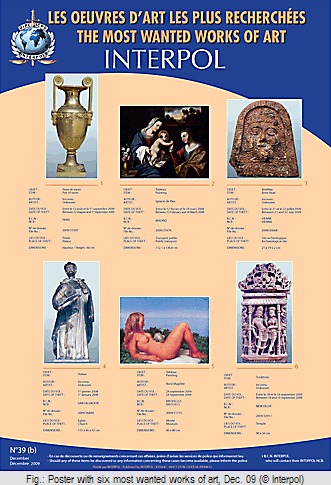There are a lot of different art crimes, theft, robbery, fraud, damage of works of art, receiving of stolen objects and the illegal excavation are the most frequent ones. Cultural property crime is profitable for many reasons; first of all it is in many cases uncomplicated to commit an art crime. Even criminal beginners are able to take sculptures out of an open church or from a public location. The stolen goods can be sold easily in the art trade, at flea-markets or in auction houses because nobody asks for the provenance of an object and no accompanying papers have to be presented.
What is Interpol?
 Interpol is the International Criminal Police Organization which actually comprises 187 member states. Interpol was founded in Vienna in 1923, and is located in Lyon, France, since 1989. Interpol is an international network that guarantees the operation and investigation of Police in foreign countries.
Interpol is the International Criminal Police Organization which actually comprises 187 member states. Interpol was founded in Vienna in 1923, and is located in Lyon, France, since 1989. Interpol is an international network that guarantees the operation and investigation of Police in foreign countries.The General Secretariat in Lyon provides divisions for all kinds of crime, amongst other the works of art unit. This unit is the central collection of information on art crime worldwide. There the Works of Art database is provided including some 35.000 stolen works of art. The Interpol stolen art database has been designed for Police and Customs and until recently was exclusively available for these authorities. Since August 2009 this Interpol database is accessible also for every interested person. That means that everybody (especially art dealers, private collectors, museum curators) has the chance to consult this database before the acquisition of an art object.
Beside the stolen art database the General Secretariat provides an openly accessible Internet site [1] where information on actual art thefts as well as recovered or found art items can be found.
Interpol publishes a poster with six most wanted works of art twice a year [2].
The search for a stolen or looted items can only be done with a photograph of good quality and a description. That is why Interpol refers to the international standard of description Object-ID [3].
Fakes
Very frequently Internet sales are used to offer fakes. After having bought such an artwork in the Internet the buyers often try to resell them profit-making in an auction house. That is where fakes often are recognised and investigations start. Due to the Internet and its possibilities the fakes often are spread worldwide and it is impossible to recover them all.
Conclusion - Solutions
As it turned out that online sales are a growing problem in many countries Interpol, UNESCO and ICOM started the Basic actions . In those Basic Actions for the first time the problems of Internet sales are defined and ways of solutions proposed. The main problems of Internet sales consist in the great number and diversity of items offered for sale, the variety of platforms for the sale of cultural objects, the limited reaction time available because of short bidding periods and the difficult legal situation concerning these sales. As "Basic Actions" the buyers are invited to check the licit provenance of an object before sale, including documents that are providing evidence for the legal export or the seller's legal title as well as checking the object with the national authorities of the country of origin. The Internet platforms are asked to cooperate with law enforcement agencies and provide the relevant information.
The self-control of Internet platforms regarding the sale of cultural property was also part of the EBay Project in Germany, Switzerland and Austria. As the offerings of archaeological objects grew at the online platform eBay and thousands of coins and archaeological objects had been offered, the three above mentioned countries contacted eBay and tried to find a solution. This solution resulted in a pilot project starting in July 2008 and still is ongoing. EBay agreed on an informal basis to change its policy concerning antiques in Germany, Switzerland and Austria by obliging sellers of antiques to include appropriate certificates that proof the rightful ownership and the provenance of the offered object. This project largely contributed to reduce offers of antiques on this platform. If a theft or other art crime is known it is crucial to inform the local Police to start the search for the object and the relevant investigations. Only when Police is informed an international search via Interpol can be initiated. Despite, the cooperation of all involved parties (law enforcement, universities, NGO´s, museums, art trade) is absolutely important to fight against the problem.
[1] http://www.interpol.int/Public/WorkOfArt/Default.asp.
[2] http://www.interpol.int/Public/WorkOfArt/Poster/Default.asp.
[3] http://icom.museum/objectid/.
[4] http://portal.unesco.org/culture/fr/files/21559/11836509429MesuresTraficIlliciteEn.pdf/MesuresTraficIlliciteEn.pdf.
e-mail: anita.gach@bmi.gv.at
This article should be cited like this: A. Gach, Illicit Trade and Interpol, Forum Archaeologiae 55/VI/2010 (http://farch.net).